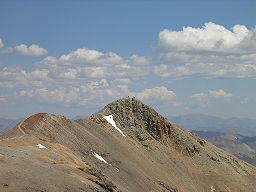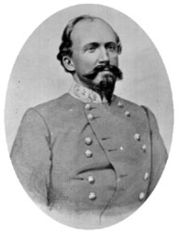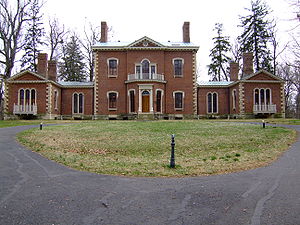
Lexington in the American Civil War
Encyclopedia

Lexington, Kentucky
Lexington is the second-largest city in Kentucky and the 63rd largest in the US. Known as the "Thoroughbred City" and the "Horse Capital of the World", it is located in the heart of Kentucky's Bluegrass region...
was a city of importance during the American Civil War
American Civil War
The American Civil War was a civil war fought in the United States of America. In response to the election of Abraham Lincoln as President of the United States, 11 southern slave states declared their secession from the United States and formed the Confederate States of America ; the other 25...
, with notable residents participating on both sides of the conflict. These included John C. Breckinridge
John C. Breckinridge
John Cabell Breckinridge was an American lawyer and politician. He served as a U.S. Representative and U.S. Senator from Kentucky and was the 14th Vice President of the United States , to date the youngest vice president in U.S...
, Confederate generals John Hunt Morgan
John Hunt Morgan
John Hunt Morgan was a Confederate general and cavalry officer in the American Civil War.Morgan is best known for Morgan's Raid when, in 1863, he and his men rode over 1,000 miles covering a region from Tennessee, up through Kentucky, into Indiana and on to southern Ohio...
and Basil W. Duke
Basil W. Duke
Basil Wilson Duke was a Confederate general officer during the American Civil War. His most noted service in the war was as second-in-command for his brother-in-law John Hunt Morgan; Duke would later write a popular account of Morgan's most famous raid: 1863's Morgan's Raid...
, and the Todd family, who mostly served the Confederacy although one, Mary Todd Lincoln
Mary Todd Lincoln
Mary Ann Lincoln was the wife of the 16th President of the United States, Abraham Lincoln, and was First Lady of the United States from 1861 to 1865.-Life before the White House:...
, was the first lady of the United States, wife of President Abraham Lincoln
Abraham Lincoln
Abraham Lincoln was the 16th President of the United States, serving from March 1861 until his assassination in April 1865. He successfully led his country through a great constitutional, military and moral crisis – the American Civil War – preserving the Union, while ending slavery, and...
.
Prominent families

Mary Todd Lincoln
Mary Ann Lincoln was the wife of the 16th President of the United States, Abraham Lincoln, and was First Lady of the United States from 1861 to 1865.-Life before the White House:...
was born there on December 13, 1818. She left in 1839 from the family home
Mary Todd Lincoln House
Mary Todd Lincoln House at 578 West Main Street in Lexington, Kentucky, USA, was the family home of the future first lady and wife of the 16th President, Mary Todd Lincoln. The three story home was the home of Robert S. Todd and his family. The family moved to the home in 1832...
to live with her sister in Springfield, Illinois
Springfield, Illinois
Springfield is the third and current capital of the US state of Illinois and the county seat of Sangamon County with a population of 117,400 , making it the sixth most populated city in the state and the second most populated Illinois city outside of the Chicago Metropolitan Area...
, where she would meet Abraham Lincoln in 1842. She went back to Lexington in 1847 to introduce her family to Lincoln on their way to Washington, D.C.
Washington, D.C.
Washington, D.C., formally the District of Columbia and commonly referred to as Washington, "the District", or simply D.C., is the capital of the United States. On July 16, 1790, the United States Congress approved the creation of a permanent national capital as permitted by the U.S. Constitution....
for Lincoln's one term as Congressman. The Lincolns returned twice more to the city in 1849 and 1850, the latter to cope with the death of a son. The Todd family was split apart by the war. Mary's father Richard Smith Todd had fourteen children, of whom six chose the Union side, while eight others went for the Confederacy. Save for Levi Todd, the Todds that remained in Lexington during the war were pro-Confederate, and did not hide their preference.
Also affected were the Breckinridges and Clays. Robert J. Breckinridge
Robert Jefferson Breckinridge
Robert Jefferson Breckinridge was a politician and Presbyterian minister. He was a member of the Breckinridge family of Kentucky, the son of Senator John Breckinridge....
was called "the strongest and sturdiest champion of the Union south of the Ohio
Ohio River
The Ohio River is the largest tributary, by volume, of the Mississippi River. At the confluence, the Ohio is even bigger than the Mississippi and, thus, is hydrologically the main stream of the whole river system, including the Allegheny River further upstream...
". However his nephew John C. Breckinridge
John C. Breckinridge
John Cabell Breckinridge was an American lawyer and politician. He served as a U.S. Representative and U.S. Senator from Kentucky and was the 14th Vice President of the United States , to date the youngest vice president in U.S...
, Vice President of the United States under Lincoln's predecessor James Buchanan
James Buchanan
James Buchanan, Jr. was the 15th President of the United States . He is the only president from Pennsylvania, the only president who remained a lifelong bachelor and the last to be born in the 18th century....
, two of his sons (Willie
William Campbell Preston Breckinridge
William Campbell Preston Breckinridge was a Democratic U.S. Representative from Kentucky, a Member of the Masonic Lodge, and a Member of the Knights Templar. He was the first cousin of Vice President of the United States John C. Breckinridge.He was born in Baltimore, Maryland, and graduated from...
and Robert Jr.), and a son-in law joined the Confederacy. Of Henry Clay
Henry Clay
Henry Clay, Sr. , was a lawyer, politician and skilled orator who represented Kentucky separately in both the Senate and in the House of Representatives...
seven grandsons, three sided with the North, and four went for the South.
The Morgans, on the other hand, were in one mind and were sympathetic to the Confederacy.
1860 – 1862

Beriah Magoffin
Beriah Magoffin was the 21st Governor of Kentucky, serving during the early part of the Civil War. Personally, Magoffin adhered to a states' rights position, including the right of a state to secede from the Union, and he sympathized with the Confederate cause...
established pro-Southern Home Guards in March 1860, the Lexington Rifles were the first to join. When Lincoln was elected President, United States flag stopped being displayed in the city. When news of the Battle of Fort Sumter
Battle of Fort Sumter
The Battle of Fort Sumter was the bombardment and surrender of Fort Sumter, near Charleston, South Carolina, that started the American Civil War. Following declarations of secession by seven Southern states, South Carolina demanded that the U.S. Army abandon its facilities in Charleston Harbor. On...
reached Lexington, the leader of the Lexington Rifles, John Hunt Morgan, telegraphed Confederate President Jefferson Davis
Jefferson Davis
Jefferson Finis Davis , also known as Jeff Davis, was an American statesman and leader of the Confederacy during the American Civil War, serving as President for its entire history. He was born in Kentucky to Samuel and Jane Davis...
to offer assistance, and raised the Confederate flag above the city's woolen factory.
The first conflict in Lexington took place in August 1861. Union cavalry arrived in the city on August 21st, numbering 200. Lexington Home Guard with Confederate sympathies quickly arrived on the scene. Former United States Vice President John C. Breckinridge, a resident of the city, negotiated between the Union cavalry and Confederate home guard, allowing the cavalry to safely depart the city. On September 19 a strong Union force returned the city, with orders to disarm the home guard. Then Captain John Hunt Morgan
John Hunt Morgan
John Hunt Morgan was a Confederate general and cavalry officer in the American Civil War.Morgan is best known for Morgan's Raid when, in 1863, he and his men rode over 1,000 miles covering a region from Tennessee, up through Kentucky, into Indiana and on to southern Ohio...
led Confederate sympathizers from the city, to rendezvous with other Confederates by the Green River
Green River (Kentucky)
The Green River is a tributary of the Ohio River that rises in Lincoln County in south-central Kentucky. Tributaries of the Green River include the Barren River, the Nolin River, the Pond River and the Rough River...
. The Union force would make the city a stronghold, and established a prison and hospital in the town.

Edmund Kirby Smith
Edmund Kirby Smith was a career United States Army officer and educator. He served as a general in the Confederate States Army during the American Civil War, notable for his command of the Trans-Mississippi Department of the Confederacy after the fall of Vicksburg.After the conflict ended Smith...
led 11,000 Confederate soldiers into the city, discovering that Union forces had destroyed their (Union) government stores before skedaddling from the city. The residents of Lexington cheered the boys in gray, prompting Smith to cable the Confederate government, saying, "They have proven to us that the heart of Kentucky is with the South in this struggle."
Following the Battle of Perryville
Battle of Perryville
The Battle of Perryville, also known as the Battle of Chaplin Hills, was fought on October 8, 1862, in the Chaplin Hills west of Perryville, Kentucky, as the culmination of the Confederate Heartland Offensive during the American Civil War. Confederate Gen. Braxton Bragg's Army of Mississippi won a...
, the Confederates left the city on October 8, with Union forces returning on October 16. However, on October 18 Morgan had returned to Lexington and captured Union Major Charles B. Seidel at Ashland, the former home of Henry Clay
Henry Clay
Henry Clay, Sr. , was a lawyer, politician and skilled orator who represented Kentucky separately in both the Senate and in the House of Representatives...
. Morgan reequipped his men, destroyed the military supplies of the city, and left. However, during the short firefight, the Confederates had managed to fire on other Confederates, causing John Hunt Morgan's brother Wash to be mortally wounded. Wash Morgan was taken to the Morgan family home of Hopemont
Hunt-Morgan House
The Hunt-Morgan House, historically known as Hopemont, is a Federal style residence in Lexington, Kentucky built in 1814 by John Wesley Hunt, the first millionaire west of the Alleghenies. The house is included in the Gratz Park Historic District. The Alexander T...
to die.
1863 – 1865
In the first three months of 1863, war refugees sympathetic to the Union arrived in the city. These mostly consisted of whites from eastern TennesseeTennessee
Tennessee is a U.S. state located in the Southeastern United States. It has a population of 6,346,105, making it the nation's 17th-largest state by population, and covers , making it the 36th-largest by total land area...
, and escaped slaves.
Morgan made his last return to the city on June 8, 1864. Having lost his better soldiers in the previous year's Morgan's Raid
Morgan's Raid
Morgan's Raid was a highly publicized incursion by Confederate cavalry into the Northern states of Indiana and Ohio during the American Civil War. The raid took place from June 11–July 26, 1863, and is named for the commander of the Confederates, Brig. Gen...
, these men proceeded to loot the city. At least $13,000 in varied monies and $25,000 of horses were taken, with clothing stores looted as well. Morgan left for Cynthiana, Kentucky
Cynthiana, Kentucky
As of the census of 2000, there were 6,258 people, 2,692 households, and 1,639 families residing in the city. The population density was 1,873.6 people per square mile . There were 2,909 housing units at an average density of 870.9 per square mile...
, where he was defeated, causing him to leave Kentucky for Virginia. Morgan was killed in Greenville, Tennessee the following September.
In February 1865 John C. Breckinridge was selected to be the Secretary of War. At the end of the war he left the country until given amnesty in 1868.
Aftermath
In 1868 John Hunt Morgan was reinterred in Lexington Cemetery. Including his brother-in-law Basil W. Duke, they are two of seven Civil War generals buried in the cemetery.There are four monuments to the Confederacy located in Lexington. Two are by the old courthouse: the John Hunt Morgan Memorial
John Hunt Morgan Memorial
The John Hunt Morgan Memorial in Lexington, Kentucky, is a monument created as a tribute to Confederate General John Hunt Morgan, who was from Lexington and is buried in nearby Lexington Cemetery....
(1911) and the John C. Breckinridge Memorial
John C. Breckinridge Memorial
John C. Breckinridge Memorial, on the courthouse lawn of Lexington, Kentucky, was placed on the National Register of Historic Places on July 17, 1997, as part of the Civil War Monuments of Kentucky MPS. It commemorates John C. Breckinridge, who had been born and died in Lexington...
(1887). The other two are in Lexington Cemetery: the Confederate Soldier Monument in Lexington
Confederate Soldier Monument in Lexington
Confederate Soldier Monument in Lexington, in Lexington Cemetery in Lexington, Kentucky, was placed on the National Register of Historic Places on July 17, 1997, as part of the Civil War Monuments of Kentucky MPS....
(1893) and the Ladies' Confederate Memorial
Ladies' Confederate Memorial
The Ladies' Confederate Memorial is an American Civil War monument erected in 1874 in Lexington Cemetery in Lexington, Kentucky. It was placed on the National Register of Historic Places on July 17, 1997, as part of the Civil War Monuments of Kentucky MPS...
(1874). There are no monuments to the Union in Lexington, unlike Louisville, where only one of the four monuments is for Confederates.

